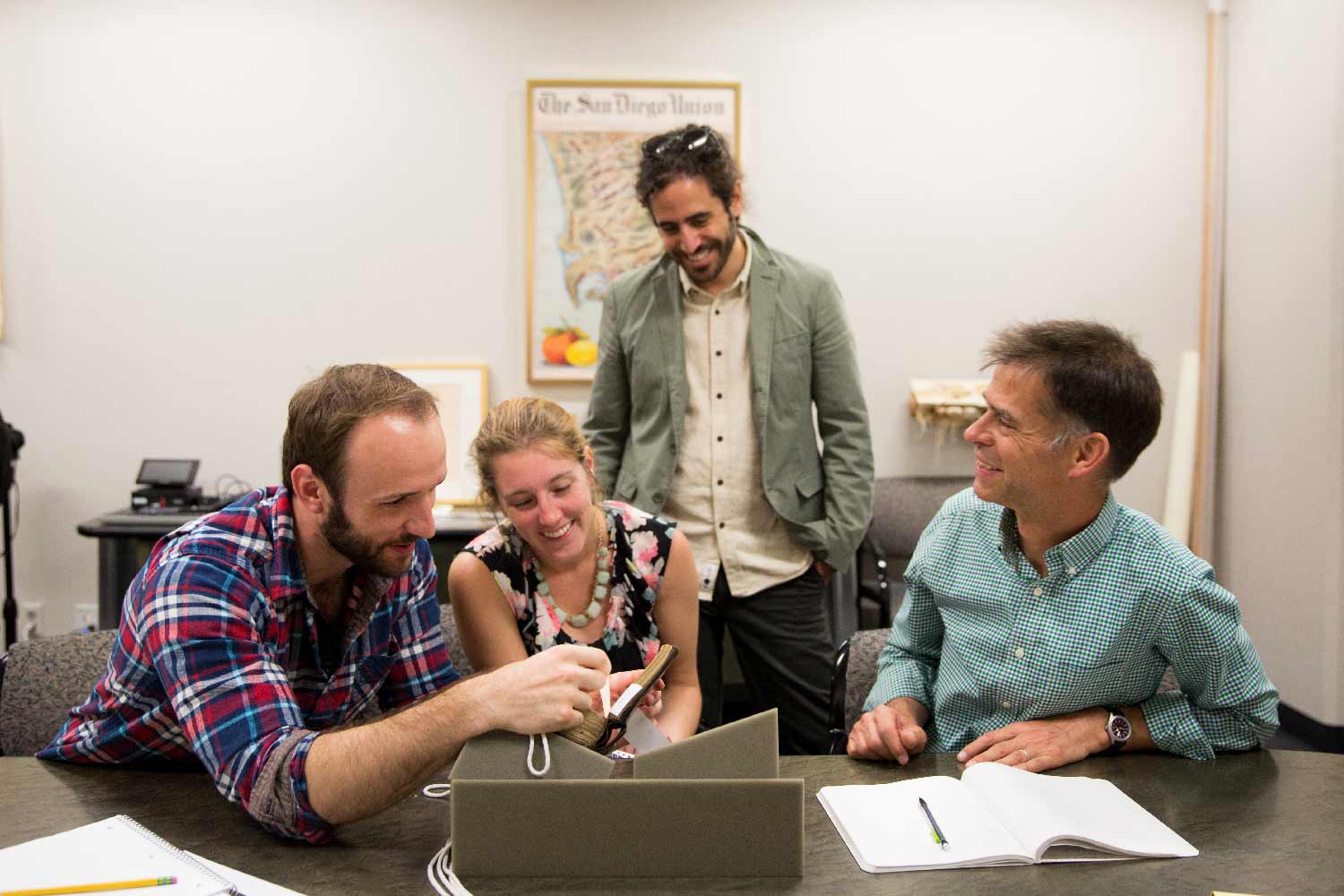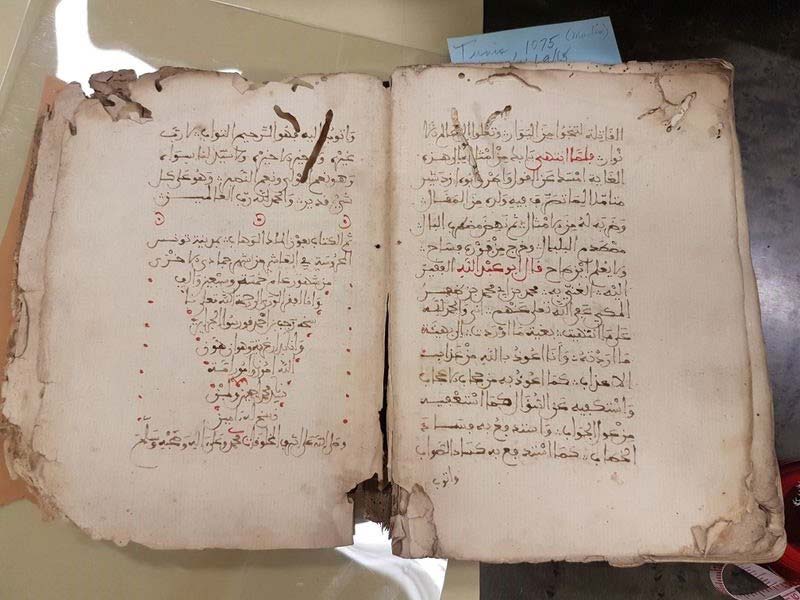
UC San Diego History Students Learn Secrets of 16th to 18th Century Islamic Manuscripts
Published Date
By:
- Cynthia Dillon
Share This:
Article Content

UC San Diego graduate student Trisha Tschopp (center), UCLA graduate student Michael O'Sullivan (left) and UC San Diego history professor Michael Provence (right) examine an Ottoman book from the 17th century while Nir Shafir looks on. Photo by Farshid Bazmandegan
The University of California San Diego’s Department of History is flush with scholars studying the fascinating histories of many parts of the world, from Africa and the Americas to the Middle East. Among them is assistant professor Nir Shafir, whose research explores what he calls “manuscript pamphlets” in the Ottoman Empire. These were cheap, short and handwritten treatises that transformed the religious and intellectual life of the Middle East over the 16th to 18th centuries. Shafir helps students see that each manuscript tells its own tale, revealed through the clues and traces left in the scripts, marginal notes, binding and paper of the manuscripts. Most recently, he gathered a small group of UC San Diego and UCLA graduate students to work together in UC San Diego Library’s Special Collections & Archives to examine newly uncovered Islamic manuscripts from the 1600s to 1800s. Shafir will conduct a second workshop on Islamic codicology May 5 at UCLA Library Special Collections.
“Even though Middle Easterners in the period knew of print, they often chose to continue copying books by hand instead,” noted Shafir. “I want to give special thanks to Lynda Claassen at UC San Diego Library’s Special Collections & Archives for first informing me of these unknown gems.” Claassen brought the manuscripts to Shafir’s attention in February, creating the impetus for his series of workshops to teach students how to analyze Islamic manuscripts.
To first approach these historical documents, workshop participants had to be able to read Arabic script, ideally in handwritten forms, and they were required to have at least one year of Arabic, Persian or Turkish language experience. The second workshop — already full — occurs at UCLA, which has the second largest collection of Islamic manuscripts in the United States, many of them uncatalogued. Part of the purpose of the workshop — and the informal group dinner that will follow in Westwood — is to encourage collaboration and discourse between graduate students from the two campuses.

The colophon of a manuscript titled “Sulwan al-Muta fi 'Udwan al-Atba'.” It was written by Ibn Zafar al-Siqilli, a 12th-century Sicilian writer, and advises princes and kings how to rule. The colophon states that the copy was completed in the city of Tunis by a certain Rajab b. Ahmad al-Jaza'iri (Rajab son of Ahmad the Algerian) on 29 Dec 1664. Photo by Nir Shafir
During the workshop’s first session at UC San Diego, Shafir split students into small groups for each to examine an unknown manuscript for 15-20 minutes before exchanging specimens. As they flipped through the folios the students were told to observe the unique characteristics of each of the manuscripts — from paper and watermarks, to color and language of the text, to binding shape and ownership marks. They took notes and then compared their findings with each other. They learned the books they examined — a thick 18th century Christian daily prayer book, written in Arabic, and embedded with printed illustrations of Christian saints, and a thinner, more cheaply bound book, written in a very Persianized Ottoman Turkish — held more information than first met the eye.
For example, Shafir compared the books’ bindings, explaining that the prayer book’s curved binding indicated a European rebinding. The other book had a four-corners “chahar-kushe” binding that used much less leather and was therefore less costly. “The cost of a book is in the binding,” he said, “and the ‘chahar-kushe’ is a form of less expensive binding developed in the 15th century.”
The Christian prayer book in Arabic featured additional Catholic images glued into the book. According to Shafir, this was highly unusual. It meant that Christians in the Middle East had daily access to printed books and manuscripts from Italy and elsewhere, or that it came from an Arabic-speaking Christian in Italy.
Another student asked about the provenance — or source location — of the paper. One way to determine this is by the watermarks embedded in the paper, only visible when held against the light. As Shafir placed the 200-300 year-old sheets on a lightbox, the watermarks appeared and students learned that starting in the 1400s, Italian paper was the most common source for paper in the Middle East and it most often features watermarks that can be used to date the paper. Interestingly, some of the manuscripts were pocked with tiny holes in the pages, called “worm holes,” showing that “true bookworms,” as one student referred to them, also enjoyed the bound content.
Nearly all the texts examined in the workshops are from the collection of Giorgio Levi della Vida, a Venetian Orientalist who taught in Rome and helped catalog Arabic manuscripts for the Vatican until he fled Italy in 1939 because of anti-Semitic laws. He held visiting positions at different universities in the U.S., including San Diego. As a token of gratitude, he initially donated his book and manuscript collection to San Diego State University. The collection was eventually transferred to UCLA, but some of his manuscripts managed to remain in UC San Diego Library’s Special Collections & Archives.
Besides conducting research and teaching, Shafir is the managing editor and a regular host of the “Ottoman History Podcast.” He is completing his first year on the UC San Diego Department of History faculty. The department offers one of the most highly ranked graduate programs in the country. It is one of six departments in the UC San Diego Division of Arts and Humanities, itself ranked No. 23 in the 2017 U.S. News and World Report’s Best Global Universities listing.
Share This:
You May Also Like
Stay in the Know
Keep up with all the latest from UC San Diego. Subscribe to the newsletter today.


